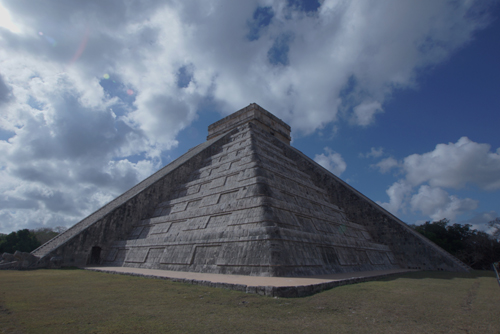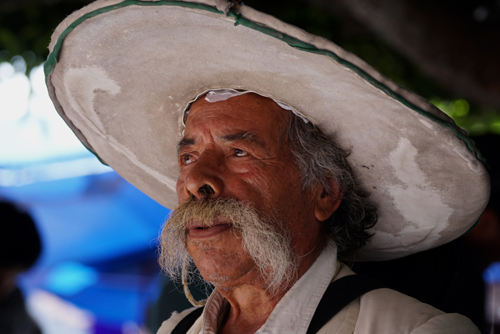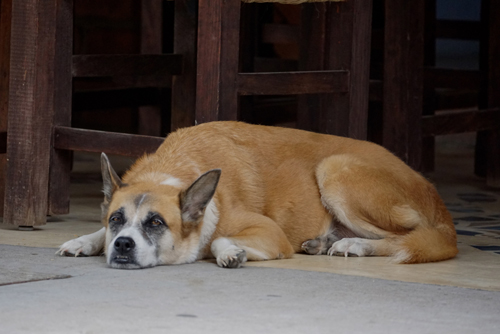We flew from Guanajuato to Cancún, the start of our tour of the Yucatán Peninsula.
Cancún.
Rather than pay for a taxi we opted for the shuttle bus, this meant we were taken the long way to our hotel, through the Zona Hotelera. It was dark so we had no idea what was there.
Our hotel was in the residential part of Cancún, where there are only smaller hotels and not resorts. This area mainly caters to Mexican tourists.
We had a long walk from near the Ado Bus Station, via Mercado 23, and then down Avenue Tulúm to the Ibis Hotel.
Here we picked up a hire car, this would be our transport for the next week.
If was late in the afternoon so we drove around the Hotel Zone just to get a feeing of what it was like in daylight.
This is about 22.5km of hotels, condominiums and resorts. These are on a thin ribbon of land, with the Caribbean Sea on one side and the Laguna Nichupè on the other.
All the accommodation stretches along the Caribbean while the facilities face the lagoon.
In a way I was glad we were staying in the more authentic, Mexican, part of Cancún.
Tulúm.
Finding Tulúm was easy, finding our hotel wasn’t.
After roaming the streets and following the directions of both Google Maps and Triposo, we gave up and asked another hotel for directions.
When we did find it, our accommodation was more B&B than hotel and on the very edge of Tulúm. Almost surrounded by jungle there was a large variety of birds, but one stood out. It was the size of a wattle bird with a shinny black chest, a teal blue and back tail and some, I’m guessing the male, have a bright yellow beak.
Tulúm Ruins was originally a walled city of the Mayan culture and an important center of worship for the so-called ‘diving god’.
Built in post-Classic period, between 1200 and 1521 AD, the city was known as Zama or Dawn, as it faces east.
This is a small site set on the shores of Caribbean and witness to the rising sun.
We tried to get there reasonably early, but we weren’t early enough, as the tour buses had already arrived.
It was even more packed when we left, two hours later.
In the afternoon we drove out of the city to the Cenote dos Ojos. Cenotes are an underground system of flooded caves, this particular one extends for over 97km.
It’s a favourite spot for divers – we just had a swim.
We then drove south of Tulúm to Sian Ka’an, a long stretch of jungle with beaches and hotels.
At the end of the road we discovered a bridge, a favourite fishing spot for the locals with a sun baking area for the Crocodiles close by.
On the way from Tulúm to Piste we stopped to visit the Cobà Ruins.
These are quite old, being developed between 600 to 800 AD and reaching their peak in 1100AD.
They are in a jungle setting and everywhere you go you can see piles of rocks emerging from the undergrowth.
Nohoch Mul is by far the largest and the one everyone has to climb. Your efforts are rewarded with an excellent view of the jungle and the lake.
The Cobà Ruins are spread over a large area, about 70 square kilometres, much of which are yet to be unearthed. To see them you can hire a bike, take a chauffeur peddled tricycle or walk.
We walked, and after about 3.5 hours, each of the many sites became indistinguishable from the last.
It was time to move on to our next destination, which was Pisté, a small village very close to Chichén Itzá.
Piste and Chichén Itzá.
We were at the gates at opening time for this World Heritage Site. Primarily to beat the heat but also the crowds and the touts.
It was a good move.
By the time we left it was hot and crowded.
Chichén Itzá was one of the largest and most culturally diverse of the Mayan cities, spanning a period between 800 and 1,200 AD.
It also has a great architectural variation, due to the span of time.
By far the most spectacular structure is El Castillo. This pyramid is primarily a 25 m high Mayan calendar of beautiful proportions.
The Mayans were a brutal race with human sacrifice their main form of entertainment.
The other site that intrigued me was Gran Juego de Pelota or the Great Ball Court. This is the largest ball court in Mexico and the place where the ‘big games’ were held.
A bit like the MCG.
The difference here is that the games often featured human sacrifice, usually the captain of the defeated side.
This would have been a real incentive not to lose.
The Ballgame in Mesoamerica dates back as far as 1,400BC. The ball was made of solid rubber and could weight up to 4kg. There were many variations to the rules but the players struck the ball with their hips, chests and arms and the objective was to keep it in the air.
The stone ball court and circular goal was a later addition.
After a number of hours wandering around the ruins in the heat we returned to our hotel.
We sat out in the rather pleasant garden, next to the pool, and enjoyed the shade of the mango trees. This proved to be rather dangerous, as the mangos would occasionally fall.
It was Easter and Mexico moved their clocks forward for Summer Time. This is the third time change we have had in the Yucatán Peninsula. The Cancún area operates on Central American time while the rest of Mexico has at least three other time zones.
Mérida.
This is the capital city of the state of Yucatán.
Approximately 60% of the population are of Mayan origins.
This is evident, not only in the people but in the craft and street performers. This is despite the fact that the Spaniards tried their darnedest to wipe them out.
We checked in to our hotel early in the afternoon and decided to head to the closest beach, Progreso, about 30 km north.
Mérida was very quiet, which is understandable, considering it was a Sunday. When we reached Progreso we realised why – they were all there, on the beach.
Our hotel in Mérida was in total contrast the one we had just left in Piste.
The Hotel Chichén Itzá, in Piste, was set in gardens with a pool and full of families. While the Gran Hotel in Mérida was more like a colonial museum. Built around a large internal court yard, there were three floors of timber, columns and tiled floors, all full of antique furniture.
It’s full name is El Legendario Gran Hotel. Built in 1901, I think it’s halcyon days were some years back.
Despite being a little frayed around the edges the hotel’s location couldn’t be faulted, being right on Calle 60 in the heart of the old city and facing the Parque de la Madre.
We drove a little way out of town to El Gran Museo del Mundo Maya de Mèrida. The museum building is a new complex, only completed in 2012, with contemporary architecture and state-of-the-art facilities.
The first part of the exhibition was about the Chicxulub crater, found in the Yucatán Peninsula. It is believed to be caused by the meteorite that resulted in the extinction of the dinosaurs during the Cretaceous Period.
The rest of the museum was dedicated to a celebration of the Mayans.
More than 3,000 years old the Mayan culture is still alive, if not a little changed by history. And with nearly six million Mayans in Mexico I think it will continue to survive.
Plaza Grande is the heart of Mérida with the the Mérida Cathedral, Catedral de San Ildefonso, dominating one end. Built between 1561 and 1598, with stone from a Mayan temple, it has an austere facade and daunting interior.
The public buildings around the Plaza Grande are like a living museum. They have a been restored and are now open to the public, for free.
We went to take the double-decker, Hop-on Hop-off bus that’s based in the square, but they didn’t have an English guide. So we walked a few blocks to Parque Santa Lucia and hopped on a bus that did.
This was in a converted 1972 Dodge, with open sides, slatted timber seats and the original shock absorbers.
The tour was excellent, if not a little hard on the backside.
Palacio de Gobierno is another of the free public buildings. It has a series of giant murals by Fernando Castro Pacheco (1918-2013), depicting the emancipation of the Mayan people.
The Mayan legacy and their integration into modern Mexican society is a constant theme that is everywhere in Mérida. They are a happy people and we were being constantly approached on the street. Yes, they wanted to sell their wares but they were equally interested in us and where we came from. They also go to great pains to tell their story.
The women, especially the older ones, still wear the traditional dress. This is white with colourful embroidery. The men wear western clothes, with many opting for the baseball cap rather than the Jipi or Panama hat, made from a palm-like fibre.
In contrast to the history of Mérida we took a day trip to Celestún to see the flamingos.
The town of Celestún, and the adjoining 600 square km, Parque Natural del Flamenco Mexicano, is west of Mérida.
The ecosystem is unique with salt water from the Gulf of Mexico and fresh water from the estuary.
There is an abundance of wildlife there, especially birds.
As the park’s name suggests, there were plenty of flamingos.
On the way to Celestún we stopped at the small town of Umán. They have a daily fruit, veg and meat market, complete with a resident DJ.
The local church, San Francisco de Assís is just over the road from the market. This, like so many others, was probably built over an existing Mayan temple. It was common practice to use the old materials as the basis for the new structure.
It’s a ancient strategy of newer regimes, wanting to exert influence and power over older cultures.
Our driver and guide was Mayan and he gave us a good insight into Mayan life.
Hammocks are sold on the streets by many vendors but we learnt that they are the preferred mode of sleeping for the Mayans.
The Ceiba tree, part of the kapok family, is known by the Mayans as the Tree of Life. The tree figures an important part in the mythologies of pre-Columbian Mesoamerican cultures.
Romance is an important part of the Mayan culture. This can be seen in their art, music, festivals and even Mérida’s street furniture.
‘Love chairs’ are dotted around public places, especially the parks.
On our last afternoon we just wandered around the old town and did some people watching and a little bit of sightseeing.
One was the Casa de Cultura Banamex Museo Casa Montejo.
This is a restored and decorated house of the Montejo family and another free activity, in the main square of Mérida. Within the house was also an exhibition of contemporary Mayan pottery, mixed with 14th century classical works.
The Banamex bank are sponsors. They are very good corporate citizens and support art and culture throughout Mexico. We had seen a similar exhibition in Mexico City.
There is also their commercial side with a gift shop and ATM on site.
We spent five night in Mérida, which wasn’t hard to do.
Life there is easy going and relaxing – we also needed time to do some forward planning.














